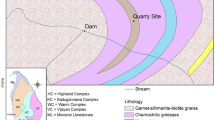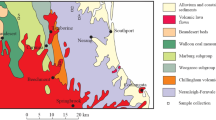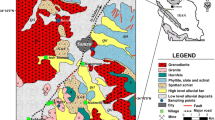Abstract
In the recent past, several weathering indices have been proposed to characterize the extent of weathering and weatherability depending upon the nature and requirement of the study. The weathering index provides a quantitative measure of the extent of weathering of rock; hence it can provide input to the prediction models to assess the strength and deformational properties of rocks and classifications of weathered rock material. In the present study some of the important weathering indices, broadly categorized as chemical, (micro) petrographical and engineering weathering indices, are reviewed and studied experimentally for three common rocks of India, namely granite of Malanjkhand, basalt of Nagpur and quartzite of Delhi, along with results of other rocks reported by other researchers. The study reveals that none of the existing chemical weathering indices is valid for genetically different common rock types and useful for engineering purposes. However, loss on ignition (LOI) may provide an approximate estimation of altered minerals (clays and hydroxides) in tested rocks. It has also shown good correlation with petrographic indices and engineering index properties. Among the petrographic indices, crack density (ρcr) and unsound constituent (an input to the micropetrographic index) indices provide good correlation with engineering index properties. To quantify the extent of weathering in terms of strength degradation due to weathering in rock, an index is suggested – strength ratio (Rs) – which is the percentage of uniaxial compressive strength (σc) of weathered rock with respect to σc of fresh rock. Its significance is shown statistically through the relationships with other indices for several rock types including sedimentary and metamorphic rocks.
Résumé.
Dans un passé récent, plusieurs indices d'altération ont été proposés pour caractériser le degré d'altération et l'altérabilité d'une roche. Donnant une mesure quantitative du degré d'altération, un indice d'altération permet d'alimenter des modèles d'évaluation des propriétés de résistance et de déformabilité des roches, ainsi que des classifications de matériaux rocheux altérés. Dans cette étude, quelques indices importants mesurant l'altération, indices sommairement classés comme chimiques, (micro-) pétrographiques et appliqués à l'ingénierie, ont été reconsidérés et mis en oeuvre expérimentalement pour trois roches communes en Inde, à savoir le granite de Malanjkhand, le basalte de Nagpur et le quartzite de Delhi. D'autres données rapportées par des chercheurs sont prises en compte. L'étude montre qu'aucun des indices d'altération chimique n'est valable pour des roches communes d'origines différentes, ni utile pour des applications d'ingénierie. Cependant, la «perte au feu» peut fournir une estimation des minéraux altérés (argiles et hydroxides) dans les roches testées. De bonnes corrélations sont également établies entre cet indice et les indices pétrographiques ainsi que les indices appliqués à l'ingénierie. Parmi les indices pétrographiques, l'indice de densité de fissures et l'indice des constituants altérés (paramètre d'entrée de l'indice micropétrographique de Irfan et Dearman) donnent de bonnes corrélations avec les indices appliqués à l'ingénierie. Afin de quantifier le degré d'altération en terme de perte de résistance, un indice Rs est défini par le rapport des résistances à la compression simple de la roche altérée et de la roche saine. Son intérêt est montré, d'un point de vue statistique, par comparaison avec d'autres indices pour plusieurs types de roches d'origines sédimentaire et métamorphique.
Similar content being viewed by others
Author information
Authors and Affiliations
Additional information
Electronic Publication
Rights and permissions
About this article
Cite this article
Gupta, A.S., Rao, S.K. Weathering indices and their applicability for crystalline rocks. Bull Eng Geol Environ 60, 201–221 (2001). https://doi.org/10.1007/s100640100113
Received:
Accepted:
Published:
Issue Date:
DOI: https://doi.org/10.1007/s100640100113




